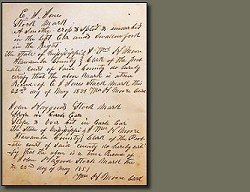 With today’s Internet research, one small error can easily be propagated into hundreds of research errors. One case in point is the death date of early Itawamba County planter, George Shumpert.
With today’s Internet research, one small error can easily be propagated into hundreds of research errors. One case in point is the death date of early Itawamba County planter, George Shumpert.Shumpert’s old monument is located in the dense woods of the old Shumpert Plantation cemetery in southwestern Itawamba County. The old thin monument is discolored and stained with more than one hundred and fifty years of exposure to the elements. The old monument is hard to read without a close inspection, but a careful inspection reveals his death date was March 19, 1853. Several years ago Shumpert descendants installed a beautiful new monument to compliment the historic monument, using the exact wording from the old monument. An inspection of Itawamba County governmental records - in particular the probate records of the George Shumpert estate, validates the death date found on both the actual historic monument and the more recently installed new monument.
 More than 37 years ago a survey of the old family cemetery was completed and an error was apparently made in the death date, changing the 1853 year to 1852. Since that time, the incorrect 1852 death date has been propagated, and since the advent of the Internet, at a much more higher rate of speed. Today most all online files and data show the 1852 date and that date is being propagated into yet more family files.
More than 37 years ago a survey of the old family cemetery was completed and an error was apparently made in the death date, changing the 1853 year to 1852. Since that time, the incorrect 1852 death date has been propagated, and since the advent of the Internet, at a much more higher rate of speed. Today most all online files and data show the 1852 date and that date is being propagated into yet more family files.The above Shumpert dilemma is one case in point that we should use published data with care. We must also keep in mind that un-sourced data in an online Gedcom file should be treated as merely a research hint and not necessarily as fact. In researching our family lines, we should always back up conveyed facts with as many source records as possible – both primary and secondary. Simply put, good genealogy research is a science, and much more than just collecting, importing and redistributing Gedcom files. A genealogist is both a sleuth and researcher, searching out and obtaining source documents to back up research theories. If data has been published, whether it be from a traditional print publication or an online website, information being published doesn’t necessarily make that information a fact. Mistakes do happen. We all make them at one time or the other.
In carrying out our research, we should always try to gather as much source material as possible to support the information we are conveying and document that gathered material by accepted standards and procedures. Correctly citing your source of information is an essential part of genealogical studies. In the long run, we will be doing ourselves, as well as those who follow us researching the same family line, a huge favor.





1 comment:
Bob, so very true. This is exactly why I used the census, ss death index, and cemetery books in my book. It is also why I wrote in the introduction to verify all info. and not just take what was in the book. Martha
Post a Comment